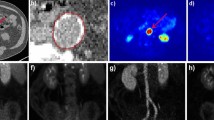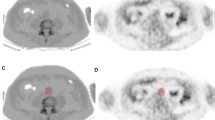Abstract
Purpose
The main aim of this research was to determine the changes of FDG uptake in large arteries with aging as visualized by FDG-PET imaging.
Methods
We examined the presence of arterial FDG uptake in 149 subjects (61 males, 88 females; age range 5–83 years) who underwent whole-body PET scans for the assessment of non-cardiovascular disorders. The subjects were divided into eight age decade groups, with at least 12 subjects in each group. The presence of FDG uptake was recorded in the ascending, arch, descending thoracic and abdominal segments of the aorta, as well as in iliac and femoral arteries. We then calculated the percentage of segments with visible FDG uptake for each age group. Mean SUVs were calculated for each of the arterial segments and compared among the age groups.
Results
Among 149 subjects, 145 were noted to have visible uptake in at least one segment of the large vessels. Percentage of segments with visible FDG uptake increased with age (p < 0.01). Mean SUVs of the ascending aorta, aortic arch, descending thoracic aorta, iliac arteries and femoral arteries increased with age (p < 0.01).
Conclusion
Prevalence and intensity of FDG uptake in large arteries generally increases with aging. Increased FDG uptake likely represents the presence of active inflammatory process of atherosclerotic plaque. The magnitude of inflammation within the wall of the large arteries increases with aging.









Similar content being viewed by others
References
Breslow JL. Cardiovascular disease burden increases, NIH funding decreases. Nat Med 1997;3 6:600–1.
Braunwald E. Shattuck lecture–cardiovascular medicine at the turn of the millennium: triumphs, concerns, and opportunities. N Engl J Med 1997;6:337(19):1360–9.
Kortelainen ML. Adiposity, cardiac size and precursors of coronary atherosclerosis in 5- to 15-year-old children: a retrospective study of 210 violent deaths. Int J Obes Relat Metab Disord 1997;21 8:691–7.
Daniels SR. Cardiovascular disease risk factors and atherosclerosis in children and adolescents. Curr Atheroscler Rep 2001;3 6:479–85.
Scott J. The pathogenesis of atherosclerosis and new opportunities for treatment and prevention. J Neural Transm Suppl 2002;63:1–17.
Hanke H, Lenz C, Finking G. The discovery of the pathophysiological aspects of atherosclerosis–a review. Acta Chir Belg 2001;101 4:162–9.
Deligonul U. Coronary angiography as a prognostic tool. Anadolu Kardiyol Derg 2001;1 3:189–96.
Naghavi M, Madjid M, Khan MR, Mohammadi RM, Willerson JT, Casscells SW. New developments in the detection of vulnerable plaque. Curr Atheroscler Rep 2001;3 2:125–35.
Tardif JC. Atherosclerosis imaging. Can J Cardiol 2005;21 12:1035–9.
Guedes A, Tardif JC. Intravascular ultrasound assessment of atherosclerosis. Curr Atheroscler Rep 2004;6 3:219–24.
Rubba P, Faccenda F. Noninvasive ultrasound techniques versus angiography for monitoring drug-induced changes of the arterial walls. FASEB J 1993;7 15:1491–8.
Gronholdt ML. B-mode ultrasound and spiral CT for the assessment of carotid atherosclerosis. Neuroimaging Clin N Am 2002;12 3:421–35.
Wasserman BA, Haacke EM, Li D. Carotid plaque formation and its evaluation with angiography, ultrasound, and MR angiography. J Magn Reson Imaging 1994;4 4:515–27.
Marchand B, Hernandez-Hoyos M, Orkisz M, Douek P. Diagnosis of renal artery stenosis with magnetic resonance angiography and stenosis quantification. J Mal Vasc 2000;25 5:312–20.
da Luz PL, Bertini PJ, Favarato D. Noninvasive detection of coronary artery disease–challenges for prevention of disease and clinical events. Clinics 2005;60 5:415–28. Epub 2005 Oct 24.
Abou-Raya A, Abou-Raya S. Inflammation: a pivotal link between autoimmune diseases and atherosclerosis. Autoimmun Rev 2006;5:331–7.
Mach F. New anti-inflammatory agents to reduce atherosclerosis. Arch Physiol Biochem 2006;112 2:130–7.
Paffen E, DeMaat MP. C-reactive protein in atherosclerosis: A causal factor? Cardiovasc Res 2006;1 71:30–9.
Rohren EM, Turkington TG, Coleman RE. Clinical Applications of PET in Oncology. Radiology 2004;231 2:305–32.
Andrews J, Al-Nahhas A, Pennell DJ, Hossain MS, Davies KA, Haskard DO, et al. Non-invasive imaging in the diagnosis and management of Takayasu’s arteritis. Ann Rheum Dis 2004;63:995–1000.
Ben-Haim S, Kupzov E, Tamir A, Israel O. Evaluation of 18F-FDG uptake and arterial wall calcifications using 18F-FDG PET/CT. J Nucl Med 2004;45:1816–21.
Zhuang H, Alavi A. 18-fluorodeoxyglucose positron emission tomographic imaging in the detection and monitoring of infection and inflammation. Semin Nucl Med 2002;32 1:47–59.
Lakatta EG. Age-associated cardiovascular changes in health: impact on cardiovascular disease in older persons. Heart Fail Rev 2002;7:29–49.
Kannel WB. Overview of atherosclerosis. Clin Ther 1998;20:B2–B17.
Fayad ZA, Fuster V. Clinical imaging of the high-risk or vulnerable atherosclerotic plaque. Circ Res 2001;17 89:305–16.
Zhang Z, Machac J, Helft G, Worthley SG, Tang C, Zaman AG. Non-invasive imaging of atherosclerotic plaque macrophage in a rabbit model with F-18 FDG PET: a histopathological correlation. BMC Nucl Med 2006;6:3.
Belhocine T, Blockmans D, Hustinx R, Vandevivere J, Mortelmans L. Imaging of large vessel vasculitis with (18)FDG PET: illusion or reality? A critical review of the literature data. Eur J Nucl Med Mol Imaging 2004;31:300–2.
Mochizuki Y, Fujii H, Yasuda S, Nakahara T, Takahashi W, Ide M, et al. FDG accumulation in aortic walls. Clin Nucl Med 2001;26:68–9.
Yun M, Yeh D, Araujo LI, Jang S, Newberg A, Alavi A. F-18 FDG uptake in the large arteries: a new observation. Clin Nucl Med 2001;26:314–9.
Ben-Haim S, Kupzov E, Tamir A, Israel O. Evaluation of 18F-FDG uptake and arterial wall calcifications using 18F-FDG PET/CT. J Nucl Med 2004;45:1816–21.
El-Haddad G, Zhuang H, Gupta N, Alavi A. Evolving role of positron emission tomography in the management of patients with inflammatory and other benign disorders. Semin Nucl Med 2004;34:313–29.
Rudd JH, Warburton EA, Fryer TD, Jones HA, Clark JC, Antoun N, et al. Imaging atherosclerotic plaque inflammation with [18F]-fluorodeoxyglucose positron emission tomography. Circulation 2002;105:2708–11
Ogawa M, Ishino S, Mukai T, Asano D, Teramoto N, Watabe H, et al. (18)F-FDG accumulation in atherosclerotic plaques: immunohistochemical and PET imaging study. J Nucl Med 2004;45:1245–50.
Weissberg PL. Noninvasive imaging of atherosclerosis: the biology behind the pictures. J Nucl Med 2004;45:1794–5.
Herrington DM, Brown WV, Mosca L, Davis W, Eggleston B, Hundley WG, et al. Relationship between arterial stiffness and subclinical aortic atherosclerosis. Circulation 2004:27;110(4):432–7.
Bural GG, Torigian DA, Chamroonrat W, Alkwaldeh K, Elhaddad G, Alavi A. Quantitative Assessment of Atherosclerotic Burden (ATHERO-BURDEN) of aorta by combined FDG-PET and CT image analysis-a new concept. Nuclear Medicine and Biology 2006;33:1037–43.
Andrews J, Mason JC. Takayasu’s arteritis–recent advances in imaging offer promise. Rheumatology (Oxford) 2007;46 1:6–15, Jan.
Walter MA, Melzer RA, Schindler C, Muller-Brand J, Tyndall A, Nitzsche EU. The value of [18F]FDG-PET in the diagnosis of large-vessel vasculitis and the assessment of activity and extent of disease. Eur J Nucl Med Mol Imaging 2005;32:674–81.
Ogawa M, Ishino S, Mukai T, Asano D, Teramoto N, Watabe H, et al. (18)F-FDG accumulation in atherosclerotic plaques: immunohistochemical and PET imaging study. J Nucl Med 2004;45 7:1245–50, Jul.
Tawakol A, Migrino RQ, Hoffmann U, Abbara S, Houser S, Gewirtz H, et al. Noninvasive in vivo measurement of vascular inflammation with F-18 fluorodeoxyglucose positron emission tomography. J Nucl Cardiol 2005;12 3:294–301, May-Jun.
Ogawa M, Magata Y, Kato T, Hatano K, Ishino S, Mukai T, et al. Application of 18F-FDG PET for monitoring the therapeutic effect of antiinflammatory drugs on stabilization of vulnerable atherosclerotic plaques. 2006 Nov;47(11):1845–50.
Tahara N, Kai H, Ishibashi M, Nakaura H, Kaida H, Baba K, et al. Simvastatin attenuates plaque inflammation: evaluation by fluorodeoxyglucose positron emission tomography. J Am Coll Cardiol 2006;48 9:1825–31, Nov 7.
van der Loo B, Koppensteiner R, Luscher TF. How do blood vessels age? Mechanisms and clinical implications. Vasa 2004;33:3–11.
Yun M, Jang S, Cucchiara A, Newberg AB, Alavi A. 18F FDG uptake in the large arteries: a correlation study with the atherogenic risk factors. Semin Nucl Med 2002;32 1:70–6.
Scheel AK, Meller J, Vosshenrich R, Kohlhoff E, Siefker U, Muller GA, et al. Diagnosis and follow up of aortitis in the elderly. Ann Rheum Dis. 2004;63:1507–10.
Kim CK, Gupta NC, Chandramouli B, Alavi A. Standardized uptake values of FDG: body surface area correction is preferable to body weight correction. J Nucl Med 1994;35 1:164–7.
Fahey FH. Positron emission tomography instrumentation. Radiol Clin North Am 2001;39:919–29.
Author information
Authors and Affiliations
Corresponding author
Rights and permissions
About this article
Cite this article
Bural, G.G., Torigian, D.A., Chamroonrat, W. et al. FDG-PET is an effective imaging modality to detect and quantify age-related atherosclerosis in large arteries. Eur J Nucl Med Mol Imaging 35, 562–569 (2008). https://doi.org/10.1007/s00259-007-0528-9
Received:
Accepted:
Published:
Issue Date:
DOI: https://doi.org/10.1007/s00259-007-0528-9




